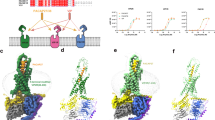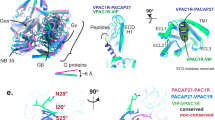Abstract
Vasoactive intestinal peptide (VIP) is a widespread neuropeptide, which exerts many biological functions through interaction with the VPAC1 receptor, a class II G protein-coupled receptor. Photoaffinity labeling studies combined with 3D molecular modeling demonstrated that the central and C-terminal parts of VIP (segment 6–28) have physical contacts with the N-terminal ectodomain (N-Ted) of VPAC1 receptor. However, the domain of the hVPAC1 receptor interacting with the N-terminus of VIP (1–5) is still unknown. We have synthesized a photoreactive probe Bpa0-VIP. After photolabeling and receptor cleavage, Nu-PAGE analysis revealed a 5-kDa labeled fragment corresponding to the 130–137 sequence of hVPAC1 receptor, indicating that the N-terminus of VIP also interacts with the N-ted. A photoreactive probe, Bpa0-PG97–269, was also synthesized with the specific peptide antagonist PG97–269. After photoaffinity labeling, a glycosylated 15-kDa fragment is identified by cyanogen bromide (CNBr) cleavage and corresponds to the 43–66 sequence of the hVPAC1 receptor N-ted. These results indicate that: (1) the N-terminal part of VIP physically interacts with the N-ted in the continuity of 6–28 VIP sequence; (2) the N-terminal part of VIP and the selective peptide antagonist (PG97–269) have different sites of interaction with the VPAC1 receptor N-ted.



Similar content being viewed by others
References
Ceraudo, E., Murail, S., Tan, Y. V., Lacapère, J. J., Neumann, J. M., Couvineau, A., et al. (2008). The vasoactive intestinal peptide (VIP) {alpha}-helix up to C terminus interacts with the N-terminal ectodomain of the human VIP/pituitary adenylate cyclase-activating peptide 1 receptor: photoaffinity, molecular modeling, and dynamics. Molecular Endocrinology, 22, 147–155.
Dong, M., Li, Z., Pinon, D. I., Lybrand, T. P., & Miller, L. J. (2004). Spatial approximation between the amino terminus of a peptide agonist and the top of the sixth transmembrane segment of the secretin receptor. Journal of Biological Chemistry, 279, 2894–2903.
Gaudin, P., Maoret, J. J., Couvineau, A., Rouyer-Fessard, C., & Laburthe, M. (1998). Constitutive activation of the human vasoactive intestinal peptide 1 receptor, a member of the new class II family of G protein-coupled receptors. Journal of Biological Chemistry, 273, 4990–4996.
Gourlet, P., De Neef, P., Cnudde, J., Waelbroek, M., & Robberecht, P. (1997). In vitro properties of a high affinity selective antagonist of the VIP1 receptor. Peptides, 18, 1555–1560.
Gozes, I., Fridkinb, M., Hill, J. M., & Brenneman, D. E. (1999). Pharmaceutical VIP: prospects and problems. Current Medicinal Chemistry, 6, 1019–1034.
Laburthe, M., Couvineau, A., & Tan, Y. V. (2007). Class II G protein-coupled receptors for VIP and PACAP: structure, models of activation and pharmacology. Peptides, 28, 1631–1639.
Nicole, P., Lins, L., Rouyer-Fessard, C., Drouot, C., Fulcrand, P., Thomas, A., et al. (2000). Identification of key residues for interaction of vasoactive intestinal peptide with human VPAC1 and VPAC2 receptors and development of a highly selective VPAC1 receptor agonist. Alanine scanning and molecular modeling of the peptide. Journal of Biological Chemistry, 275, 24003–24012.
Sherwood, N. M., Krueckl, S. L., & McRory, J. E. (2000). The origin and function of the pituitary adenylate cyclase-activating polypeptide (PACAP)/glucagon superfamily. Endocrine Reviews, 21, 619–670.
Tan, Y. V., Couvineau, A., & Laburthe, M. (2004). Diffuse pharmacophoric domains of vasoactive intestinal peptide (VIP) and further insights into the interaction of VIP with the N-terminal ectodomain of human VPAC1 receptor by photoaffinity labeling with [Bpa6]-VIP. Journal of Biological Chemistry, 279, 38889–38894.
Tan, Y. V., Couvineau, A., Murail, S., Ceraudo, E., Neumann, J. M., Lacapère, J. J., et al. (2006). Peptide agonist docking in the N-terminal ectodomain of a class II G protein-coupled receptor, the VPAC1 receptor. Photoaffinity, NMR, and molecular modeling. Journal of Biological Chemistry, 281, 12792–12798.
Tan, Y. V., Couvineau, A., Van Rampelbergh, J., & Laburthe, M. (2003). Photoaffinity labeling demonstrates physical contact between vasoactive intestinal peptide and the N-terminal ectodomain of the human VPAC1 receptor. Journal of Biological Chemistry, 78, 36531–36536.
Acknowledgements
This research was supported by the Institut National de la Santé et de la Recherche Médicale, the Université Paris-Diderot (Paris 7) and also by a grant from Association de Recherche sur la Polyarthrite. E. Ceraudo is supported by grant FDT20070910820 from the Fondation pour la Recherche Médicale and by an « Interuniversity Poles of Attraction Program » (PAI) from Université Libre de Bruxelles (ULB), Belgium.
Author information
Authors and Affiliations
Corresponding author
Rights and permissions
About this article
Cite this article
Ceraudo, E., Tan, YV., Nicole, P. et al. The N-Terminal Parts of VIP and Antagonist PG97–269 Physically Interact with Different Regions of the Human VPAC1 Receptor. J Mol Neurosci 36, 245–248 (2008). https://doi.org/10.1007/s12031-008-9073-7
Received:
Accepted:
Published:
Issue Date:
DOI: https://doi.org/10.1007/s12031-008-9073-7




